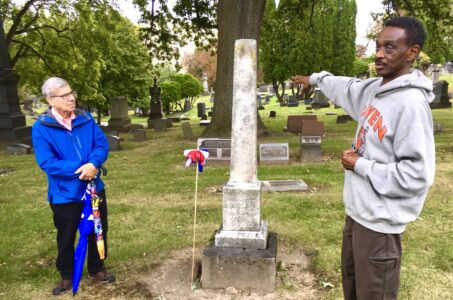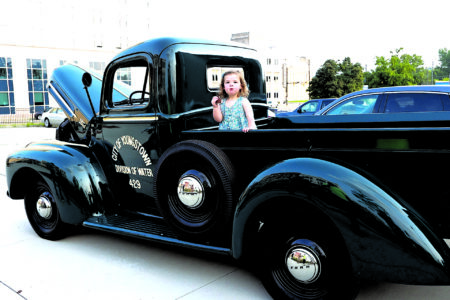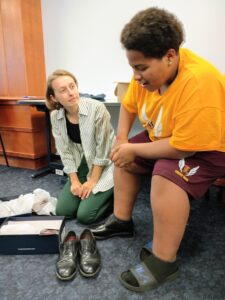Black heritage bus tour rolls through Youngstown’s past

Correspondent photo / Sean Barron Vincent A. Shivers, a local historian, points to P. Ross Berry’s headstone in Oak Hill Cemetery in Youngstown, which was one of the stops on a black heritage tour Saturday. At left is Mike Shepherd of Boardman, who was one of 40 or 50 people on the tour.
YOUNGSTOWN — What was once a small, sparsely populated hamlet was converted into the flourishing, industrial city of Youngstown, thanks in large part to the sweat, toil, ingenuity, craftsmanship and innovations of many blacks, a longtime local historian says.
“The earliest building we know he worked on was the Lawrence County (Pa.) Courthouse,” Vincent A. Shivers said, referring to P. Ross Berry, who was the masonry contractor for, and builder of, many of the most significant structures in Youngstown and the Mahoning Valley during the 19th century.
Around age 16, Berry began his career as a bricklayer and stonemason before having his handprints as a master builder on numerous well-known buildings that include the first Rayen School, the Youngstown Opera House, the downtown jail on Hazel Street, the 1876 Mahoning County Courthouse, the second St. Columba Church sanctuary, Gov. David Tod’s 14-room Youngstown mansion and others. Tod, a Democrat, served one two-year term as Ohio governor from 1862 to 1864.
Berry also was among the prominent black pioneers whose work and achievements in the city’s foundation, settlement and development were recognized and honored during a black heritage bus tour Saturday that began at the Tyler History Center, 325 W. Federal St., downtown.
Additional support for the event came from Mahoning Valley Sojourn to the Past, Lit Youngstown and the Raymond J. Wean Foundation.
Between 40 and 50 people took the tour that included stops in Oak Hill Cemetery on the South Side, as well as along the Wick Avenue corridor.
Berry came with his family to Youngstown from New Castle, Pa., in the 1860s, and he began learning his trade around age 12. After his arrival, he gave about $1,000 to help build city hall in Youngstown, Shivers said, noting that Berry also hired white workers during slavery.
“He understood diversity,” Shivers said, adding that education also was a top priority in the Berry family.
Berry died in 1917 at age 82 and is among the prominent blacks buried in Oak Hill Cemetery, which was the first stop along the tour. Also among those interred in the 25-acre sprawling cemetery is Penelope Richards, a black nurse during the Civil War — a rarity in Youngstown at that time, Shivers noted.
Richards later worked in a Washington, D.C., hospital that eventually became part of Howard University, one of the country’s historically black colleges and universities. Next to Richards’ gravesite is a star indicating she had been in the Grand Army of the Republic, a fraternal organization founded in 1866 and made up of Civil War veterans who had served in the Union Army and Navy, as well as the Marines.
Shivers noted that Youngstown also was a key part of the Underground Railroad, and mentioned Henry Burnett, a popular abolitionist in the city who also had business dealings with Berry, who bought land from Burnett. Shivers added that another Underground Railroad, rarely discussed and known, also served as a passage for slaves to escape to Mexico.
Shivers also made a stop at the resting place of Daniel and Melinda Knight, the latter of whom was one of the city’s earliest black business women.
The cemetery tour also included a visit to a section called soldiers lot, where many Civil War soldiers are buried. Despite slavery, as well as the overall racism and prejudice of the time, black and white soldiers were laid to rest there, Steffon Jones, a longtime local historian, noted.
“In this area, they did not discriminate,” he said, adding that five Civil War prisoners of war also are interred at the site.
One of those was Col. John B. Housteau, who came from Toronto and lived in New York before settling in the Mahoning Valley. During the war, he served under General William Tecumseh Sherman, Jones noted.
In addition, Housteau was a merchant tailor, and it’s been said that he used the first Singer sewing machine, Jones said.
Also buried in the area is Pvt. James A. Cheney, who was born into slavery in 1843 before he enlisted in the 5th United States Colored Cavalry, a regiment of the U.S. Army that was organized in October 1864 in Kentucky after its first two battles. Many who served were slaves, free men or those who escaped to Union lines.
After the war, Cheney, who had been stationed at Camp Nelson, Kentucky, moved to Youngstown, then became a barber and a merchant, Jones said.
Before the bus tour, Shivers gave a presentation at the Tyler History Center in which he outlined several other blacks who played a vital role in Youngstown’s early years, including Thomas D. Johnson, a mason by trade who served in the Civil War. In August 1864, Johnson enlisted in Company A, 127th Regiment, U.S. Colored Troops.
Others he discussed were William R. Stewart, an attorney who also worked on a viaduct along the Market Street Bridge; Charles L. Berry, a bricklayer who built some structures near Youngstown State University and is a son of P. Ross Berry; Lemeul A. Stewart, a charter member of the Local 8 Bricklayers Union; and Marcus Garvey, a Jamaican political activist who founded the Universal Negro Improvement Association and the African Communities League.



